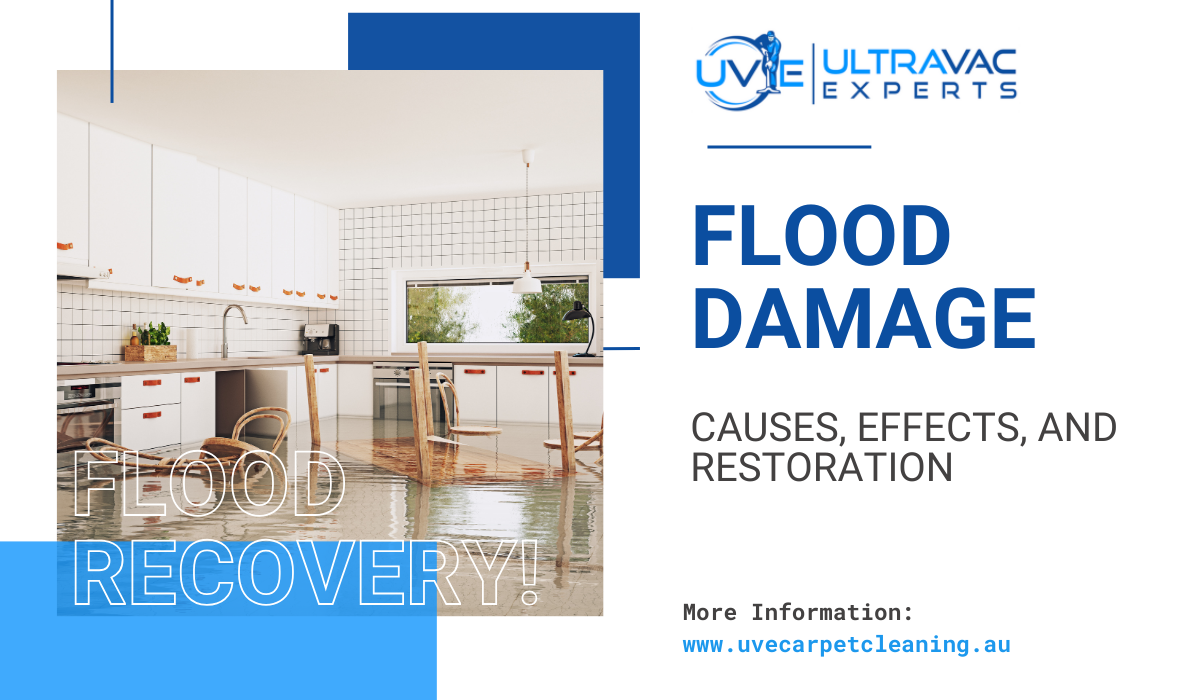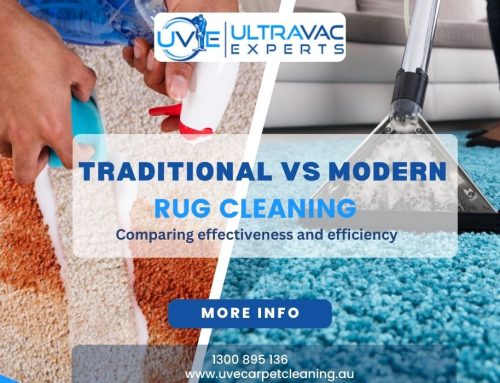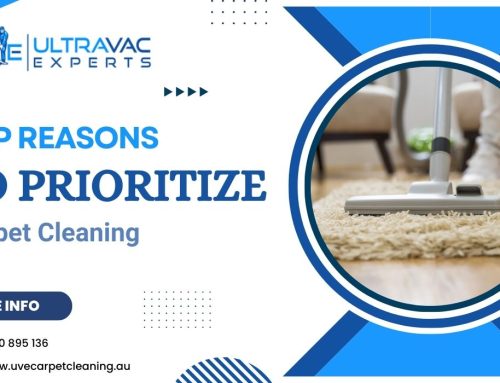Flooding can wreak havoc on homes and businesses, causing extensive damage that requires immediate attention. Ultravac Experts specializes in professional flood damage restoration services in West Ryde and nearby suburbs, with a focus on swift, effective solutions. In this blog, we will define flood damage, explore its causes and effects, and provide a comprehensive guide to the restoration process. Our goal is to help you understand the importance of timely intervention and how Ultravac Experts can restore your property to its former glory.
1. Understanding Flood Damage
What is Flood Damage?
Flood damage occurs when excess water infiltrates buildings, causing structural and material deterioration. It can result from natural events like heavy rain or man-made issues such as plumbing failures. Whether the flood is minor or severe, it can lead to significant damage if not addressed promptly.
Types of floods that typically cause damage include:
- Flash floods are caused by sudden, intense rainfall.
- River overflows, where water bodies rise above their normal levels.
- Heavy rainfall, can overwhelm drainage systems and lead to water accumulation.
Flooding affects homes, businesses, and personal belongings, leading to the destruction of property, furniture, electronics, and in severe cases, long-term structural damage.
2. Common Causes of Flood Damage
Heavy Rainfall and Storms
West Ryde’s climate often subjects its residents to heavy rain and storms, especially during extreme weather events. These conditions frequently result in flash floods, overwhelming both residential and commercial properties.
Overflowing Water Bodies
West Ryde’s rivers, lakes, and creeks can rise above normal levels, particularly after prolonged rainfall. Nearby homes and businesses are at risk of flooding when these water bodies overflow, leading to significant water damage.
Blocked or Broken Drainage Systems
Urban areas are susceptible to drainage issues. Clogged drains, gutters, or sewers can cause water to accumulate, often resulting in localized flooding. When not maintained properly, these systems fail to manage excessive rainfall.
Burst Pipes and Plumbing Failures
Internal problems, like burst pipes or sewage backups, can also lead to severe indoor flooding. Even a small pipe leak can escalate, causing extensive water damage within a short time frame.
Dam Failures or Leaking Water Heaters
Structural issues such as dam failures or leaking water heaters can also pose serious flood risks within properties. These problems often catch homeowners off guard and require immediate attention to avoid long-term damage.
3. Human-Induced Factors
Blocked Drainage
When drains, pipes, or culverts become clogged with debris, it prevents rainwater from flowing away properly. This leads to water buildup and localized flooding during heavy rains, especially in urban areas with limited green space for water absorption.
Overdevelopment
The rapid expansion of urban areas replaces natural, permeable surfaces with impermeable materials like concrete and asphalt. This limits the ground’s ability to absorb rainwater, increasing runoff, which overwhelms drainage systems and causes floods.
Climate Change
Rising global temperatures lead to unpredictable rainfall patterns and rising sea levels. This increases the intensity and frequency of flood events, particularly in coastal areas or regions experiencing extreme weather conditions.
Poor Infrastructure
Outdated or poorly maintained drainage systems, levees, and dams are often unable to handle heavy rainfall, making communities more vulnerable to flooding. Upgrades and better planning are needed to mitigate this risk.
When drains, pipes, or culverts become clogged with debris, it prevents rainwater from flowing away properly. This leads to water buildup and localized flooding during heavy rains, especially in urban areas with limited green space for water absorption.
Overdevelopment
The rapid expansion of urban areas replaces natural, permeable surfaces with impermeable materials like concrete and asphalt. This limits the ground’s ability to absorb rainwater, increasing runoff, which overwhelms drainage systems and causes floods.
Climate Change
Rising global temperatures lead to unpredictable rainfall patterns and rising sea levels. This increases the intensity and frequency of flood events, particularly in coastal areas or regions experiencing extreme weather conditions.
Poor Infrastructure
Outdated or poorly maintained drainage systems, levees, and dams are often unable to handle heavy rainfall, making communities more vulnerable to flooding. Upgrades and better planning are needed to mitigate this risk.
4. Immediate Effects of Flood Damage
Water Contamination
Floodwater often carries harmful bacteria, sewage, and chemicals, which pose health risks if not properly treated. Exposure to contaminated water can lead to various health hazards, making immediate sanitization crucial.
Damage to Structures and Foundations
Flooding weakens building structures, affecting walls, floors, and foundations. Untreated water damage can lead to dangerous mold growth and deterioration of materials like wood and drywall, compromising the integrity of the property.
Damage to Furniture, Electronics, and Personal Belongings
Household items, furniture, and expensive electronics are often ruined when exposed to floodwaters. Recovering these items can be challenging, and insurance claims may be necessary for damage recovery.
Electrical Hazards
Floodwater in contact with outlets or electrical wiring can pose serious electrocution risks. It is essential to turn off power immediately following flooding to prevent life-threatening accidents.
5. Long-Term Consequences of Untreated Flood Damage
Mold and Mildew Growth
In moist environments, mold and mildew thrive. If water damage is left untreated, mold growth can become rampant, posing significant health risks and making homes unsafe. Removing mold after prolonged exposure can be extremely challenging and costly.
Decreased Property Value
Flood damage can drastically reduce the resale value of a property. Without professional restoration, lingering issues such as structural weakening or hidden mold can make it difficult to sell the property in the future.
Pest Infestations
Standing water attracts pests like insects and rodents, which can cause further damage to homes and businesses. These infestations can lead to additional repair costs and health hazards.
6. Effective Flood Damage Restoration Solutions
Assessment and Inspection
Before restoration begins, professionals must evaluate the extent of the damage. Ultravac Experts uses advanced tools to inspect the property thoroughly and develop a tailored restoration plan.
Water Extraction and Drying
The first step in restoration is the rapid removal of standing water. Ultravac Experts uses industrial-grade pumps and vacuums to extract water, followed by the use of dehumidifiers and fans to dry out the area completely.
Sanitization and Disinfection
Contaminated floodwaters necessitate thorough cleaning. Ultravac Experts uses eco-friendly cleaning products to sanitize affected areas, ensuring your home is safe from harmful bacteria and mold spores.
Structural Repairs and Restoration
Our team repairs any structural damage to walls, floors, and foundations. For severe cases, partial demolition may be necessary to rebuild the damaged areas effectively.
Mold Remediation
Mold can quickly develop in damp environments post-flood. Ultravac Experts specializes in mold remediation, ensuring that every trace of mold is removed to protect your health and home environment.
RELATED RESOURCE: Flood Water Damage Restoration Steps
7. Preventive Measures to Minimize Flood Damage in the Future
Regular Home Maintenance
Routine maintenance of gutters, drains, and sump pumps helps prevent blockages and water accumulation. Ensuring these systems are in working order can minimize the risk of flood damage.
Installing Flood Barriers
Flood barriers and waterproofing systems can protect vulnerable areas of your home from future flooding. These measures act as a first line of defense against incoming water.
Improving Drainage Systems
Proper landscape grading and the installation of French drains help direct water away from the property, preventing flooding during heavy rain.
Elevating Essential Systems
Raising critical systems such as water heaters, HVAC units, and electrical panels above flood-prone areas can prevent severe damage during a flood.
8. Why Choose Ultravac Experts for Flood Damage Restoration in West Ryde?
Ultravac Experts has extensive experience in flood damage restoration across West Ryde. Our team is equipped with state-of-the-art equipment, ensuring quick response times and professional service. With a focus on customer satisfaction, we offer tailored restoration plans to fit each client’s unique needs. Our successful projects and glowing testimonials from satisfied customers speak to our expertise and commitment to quality.
Flood damage, if left untreated, can lead to long-term structural and health issues. Acting quickly and contacting professionals like Ultravac Experts can help prevent further damage and restore your property to its original condition. If you’ve experienced flood damage, don’t wait—reach out to us for a free assessment and let our experts handle the restoration process. contact Ultravac Experts today. We are available to assist with your restoration needs at +61 403 670 035 or 1300 895 136. You can also reach us via email at admin@ultravacexperts.com.au. Our team is ready to provide expert assistance and restore your property to its original condition.









Leave A Comment